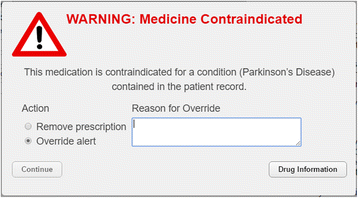Automation bias in electronic prescribing
- PMID: 28302112
- PMCID: PMC5356416
- DOI: 10.1186/s12911-017-0425-5
Automation bias in electronic prescribing
Abstract
Background: Clinical decision support (CDS) in e-prescribing can improve safety by alerting potential errors, but introduces new sources of risk. Automation bias (AB) occurs when users over-rely on CDS, reducing vigilance in information seeking and processing. Evidence of AB has been found in other clinical tasks, but has not yet been tested with e-prescribing. This study tests for the presence of AB in e-prescribing and the impact of task complexity and interruptions on AB.
Methods: One hundred and twenty students in the final two years of a medical degree prescribed medicines for nine clinical scenarios using a simulated e-prescribing system. Quality of CDS (correct, incorrect and no CDS) and task complexity (low, low + interruption and high) were varied between conditions. Omission errors (failure to detect prescribing errors) and commission errors (acceptance of false positive alerts) were measured.
Results: Compared to scenarios with no CDS, correct CDS reduced omission errors by 38.3% (p < .0001, n = 120), 46.6% (p < .0001, n = 70), and 39.2% (p < .0001, n = 120) for low, low + interrupt and high complexity scenarios respectively. Incorrect CDS increased omission errors by 33.3% (p < .0001, n = 120), 24.5% (p < .009, n = 82), and 26.7% (p < .0001, n = 120). Participants made commission errors, 65.8% (p < .0001, n = 120), 53.5% (p < .0001, n = 82), and 51.7% (p < .0001, n = 120). Task complexity and interruptions had no impact on AB.
Conclusions: This study found evidence of AB omission and commission errors in e-prescribing. Verification of CDS alerts is key to avoiding AB errors. However, interventions focused on this have had limited success to date. Clinicians should remain vigilant to the risks of CDS failures and verify CDS.
Keywords: Automation bias; Clinical; Cognitive biases; Complexity; Decision support systems; Electronic prescribing; Human-automation interaction; Human-computer interaction; Medication errors.
Figures



References
-
- Britt H, Miller G, Henderson J, Bayram C, Harrison C, Valenti L, Wong C, Gordon J, Pollack A, Pan Y, et al. General practice activity in Australia 2014–15. General practice series no. 38. Sydney: Sydney University Press; 2015.
-
- van Rosse F, Maat B, Rademaker CMA, van Vught AJ, Egberts ACG, Bollen CW. The effect of computerized physician order entry on medication prescription errors and clinical outcome in pediatric and intensive care: a systematic review. Pediatrics. 2009;123(4):1184–1190. doi: 10.1542/peds.2008-1494. - DOI - PubMed
Publication types
MeSH terms
LinkOut - more resources
Full Text Sources
Other Literature Sources
Medical

